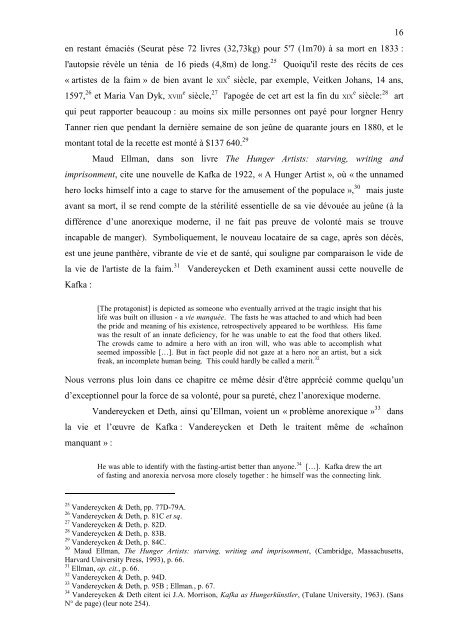S'ANEANTIR OU S'EPANOUIR : - ResearchSpace@Auckland - The ...
S'ANEANTIR OU S'EPANOUIR : - ResearchSpace@Auckland - The ...
S'ANEANTIR OU S'EPANOUIR : - ResearchSpace@Auckland - The ...
Create successful ePaper yourself
Turn your PDF publications into a flip-book with our unique Google optimized e-Paper software.
en restant émaciés (Seurat pèse 72 livres (32,73kg) pour 5'7 (1m70) à sa mort en 1833 :<br />
l'autopsie révèle un ténia de 16 pieds (4,8m) de long. 25 Quoiqu'il reste des récits de ces<br />
« artistes de la faim » de bien avant le XIX e siècle, par exemple, Veitken Johans, 14 ans,<br />
1597, 26 et Maria Van Dyk, XVIII e siècle, 27 l'apogée de cet art est la fin du XIX e siècle: 28 art<br />
qui peut rapporter beaucoup : au moins six mille personnes ont payé pour lorgner Henry<br />
Tanner rien que pendant la dernière semaine de son jeûne de quarante jours en 1880, et le<br />
montant total de la recette est monté à $137 640. 29<br />
Maud Ellman, dans son livre <strong>The</strong> Hunger Artists: starving, writing and<br />
imprisonment, cite une nouvelle de Kafka de 1922, « A Hunger Artist », où « the unnamed<br />
hero locks himself into a cage to starve for the amusement of the populace », 30 mais juste<br />
avant sa mort, il se rend compte de la stérilité essentielle de sa vie dévouée au jeûne (à la<br />
différence d’une anorexique moderne, il ne fait pas preuve de volonté mais se trouve<br />
incapable de manger). Symboliquement, le nouveau locataire de sa cage, après son décès,<br />
est une jeune panthère, vibrante de vie et de santé, qui souligne par comparaison le vide de<br />
la vie de l'artiste de la faim. 31 Vandereycken et Deth examinent aussi cette nouvelle de<br />
Kafka :<br />
[<strong>The</strong> protagonist] is depicted as someone who eventually arrived at the tragic insight that his<br />
life was built on illusion - a vie manquée. <strong>The</strong> fasts he was attached to and which had been<br />
the pride and meaning of his existence, retrospectively appeared to be worthless. His fame<br />
was the result of an innate deficiency, for he was unable to eat the food that others liked.<br />
<strong>The</strong> crowds came to admire a hero with an iron will, who was able to accomplish what<br />
seemed impossible […]. But in fact people did not gaze at a hero nor an artist, but a sick<br />
freak, an incomplete human being. This could hardly be called a merit. 32<br />
Nous verrons plus loin dans ce chapitre ce même désir d'être apprécié comme quelqu’un<br />
d’exceptionnel pour la force de sa volonté, pour sa pureté, chez l’anorexique moderne.<br />
Vandereycken et Deth, ainsi qu’Ellman, voient un « problème anorexique » 33 dans<br />
la vie et l’œuvre de Kafka : Vandereycken et Deth le traitent même de «chaînon<br />
manquant » :<br />
He was able to identify with the fasting-artist better than anyone. 34 […]. Kafka drew the art<br />
of fasting and anorexia nervosa more closely together : he himself was the connecting link.<br />
25<br />
Vandereycken & Deth, pp. 77D-79A.<br />
26<br />
Vandereycken & Deth, p. 81C et sq.<br />
27<br />
Vandereycken & Deth, p. 82D.<br />
28<br />
Vandereycken & Deth, p. 83B.<br />
29<br />
Vandereycken & Deth, p. 84C.<br />
30<br />
Maud Ellman, <strong>The</strong> Hunger Artists: starving, writing and imprisonment, (Cambridge, Massachusetts,<br />
Harvard University Press, 1993), p. 66.<br />
31<br />
Ellman, op. cit., p. 66.<br />
32<br />
Vandereycken & Deth, p. 94D.<br />
33<br />
Vandereycken & Deth, p. 95B ; Ellman., p. 67.<br />
34<br />
Vandereycken & Deth citent ici J.A. Morrison, Kafka as Hungerkünstler, (Tulane University, 1963). (Sans<br />
N° de page) (leur note 254).<br />
16














